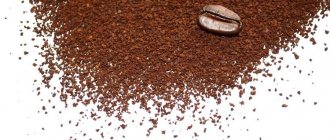Why Grinding Affects Taste
The grain should extract aromas and flavors into the water within a short time - about 3 minutes. In this case, the liquid should not be very hot - no more than 92 degrees. The larger the particles, the longer it takes the boiling water to penetrate inside and wash away all substances.
If the beans are ground into dust, extraction occurs instantly, and the drink becomes thick and rich - what true connoisseurs of coffee taste need.
Main types of coffee
Arabian and Congolese coffee trees are widely cultivated. Their beans are used to create the most beloved coffee varieties - Robusta and Arabica. Bengal and Cameroon trees are also grown in small quantities.
In total, there are 4 main types of coffee:
Coffee trees are processed on an industrial scale in countries with a predominantly tropical climate. Wild coffee trees are found on the hills of Asia and Africa. All parts of coffee trees contain caffeine, a substance produced by plants as a biological weapon to repel parasites.
Blooming coffee is something indescribable! A wealth of small snow-white flowers with a pleasant fruity scent.
The flowers themselves are bisexual, capable of independent pollination. Coffee fruits ripen within 3-4 months. When ripe, these are mostly red elliptical berries, under the skin of which there are greenish-gray grains. Each fruit usually contains two seeds, but from time to time there is one, but a very large one. These seeds are called pearl seeds; they are selected separately and are valued higher. Such grains are roasted more moderately, their taste is subtler. Special connoisseurs of coffee as a drink prefer pearl beans for its production.
Coffee beans grown in different countries and in different areas have their own unique characteristics (smell, coffee strength, taste). The special properties of the beans are determined not only by the type of coffee trees, but also by the agricultural technology of feeding and environmental conditions. This means that the characteristics of coffee beans of the 1st and the same variety can vary significantly from plantation to plantation. Single-origin is the name given to coffee that originates in the same area.
Currently, mainly small-sized coffee trees are cultivated. This is due to the convenience of care and harvesting. Coffee trees prefer light, moderately moist soil, rich in elements such as nitrogen, phosphorus oxide and potassium carbonate, and moist air. Such conditions contribute to obtaining the most valuable drink in terms of taste.
Arabica or Robusta - differences in taste in Turk
There are two industrial varieties of grain - Arabica and Robusta. They differ from each other in the shape of the beans, taste, and caffeine content. If Arabica in each region changes its taste characteristics depending on the type of soil, climate, and changes shades from citrus to spicy, then Robusta is less susceptible to environmental conditions.
If you brew Arabica, Robusta separately, and then a mixture of these beans in a certain proportion, you will get the following result:
- Pure Arabica has a mild taste. Depending on the variety and region of cultivation, it will have certain notes - chocolate, fruit, wine, tart. There is less caffeine in Arabica, so the rush of vivacity is felt weakly, but you can appreciate the shades of the aftertaste.
- Robusta gives bitterness. The aftertaste is slightly different, but due to the high caffeine content, a sharp surge of energy occurs and the person wakes up.
- A blend of Robusta and Arabica in a 30/70 ratio provides the optimal combination of taste and invigorating effect.
When brewing, the best ground coffee for Turkish coffee is a mixture of bean varieties; which one is better to choose in the taste rating is difficult to say right away, since coffee trees are grown in every region of the tropical belt.
To be an expert in coffee drinks, you need to try many varieties - highland, lowland. Preferably brought from abroad, and not purchased in local stores.
How to grind grains?
You can grind coffee beans in a regular coffee grinder. High quality burr type coffee grinder. The grains are ground using two millstones located at some distance from each other. By independently adjusting the distance between the coffee grinder millstones, you can obtain a different grind of coffee beans. A distinctive feature of this coffee grinder is the presence of a container for ground coffee.
- Popular recipes for making Turkish coffee on a gas stove. How to properly brew a delicious drink at home?
There is another type of coffee grinder - rotary. In such a coffee grinder, coffee is ground using knives rotating at high speed. The degree of grinding of coffee beans in a rotary coffee grinder is determined by the amount of time. The longer the beans are ground in the coffee grinder, the finer the grind. The disadvantages of this coffee grinder are uneven grinding and the absence of a container for ground coffee.
Important! The coffee grinder should not be used to grind other foods. It retains foreign odors for a long time.
To prepare a coffee drink in a Turk, the coffee beans must be ground immediately before brewing. We grind the coffee beans very finely to obtain an aromatic and rich coffee drink. Ground coffee beans of a grinding degree in the form of powder are more suitable for making Turkish coffee in a Turk.
To get a truly tasty and aromatic coffee drink, you also need to choose a type of coffee suitable for preparation in a Turk.
How to choose a grain variety
How to choose ground coffee beans for Turkish: the rating is opened by expensive elite high-mountain varieties. There are few such plantations in the world - not every country can boast of mountain ranges of volcanic origin.
This is where the most delicious coffee is grown. Volcanic soil is rich in nutrients erupted from the depths of the earth. Trees on such soil grow on their own - without additional fertilizing and spraying against fungus and parasites.
The bean coffee for Turkish coffee with a lower rating can be called lowland Arabica. Its grains are not as dense and heavy as mountain grains, but they have their own advantages.
Next comes Indian Arabica. In India, weather conditions change frequently and it rains, so the harvest is inconsistent in taste. For this reason, grains are mostly used to make instant drinks.
Robusta also comes in different varieties - some are more bitter, others are less bitter. For example, robusta from Uganda or Vietnam has a mild taste. If you boil it in a Turkish pot, you get a good strong drink with a bitter aftertaste.
Coffee in packs
Which ground Turkish coffee to choose if there are no specialized stores nearby: personal experience decides everything here. Counterfeits often end up in retail outlets, so your opinion about the product may change. After trying crushed ready-to-brew analogues, you can choose the best ground coffee for Turkish coffee in the ratings of local stores.
Tips for choosing Turkish
Of course, many people prefer a coffee maker, saving their time, since it makes coffee much faster and easier. It is more difficult to spoil a coffee drink in a coffee maker than in a Turk. It is enough to add the required amount of coffee, sugar, add the required amount of water and after a while you will get the finished drink. But coffee, prepared correctly in Turkish coffee, outshines any other drinks in its taste.
Once you try Turkish coffee, you will make it again and again.
It is very important to choose a Turk. The sizes are selected individually, taking into account the required volume of coffee. True connoisseurs and connoisseurs of coffee drinks believe that the smaller the size of the cezve, the tastier and more aromatic the coffee.
The most popular metal Turks. The most aromatic and unique coffee drink will be obtained in a copper Turk. The inner coating of the walls of the Turk must be made of tin. It is necessary to periodically inspect the container for visible damage to the internal coating.
There are also Turks made of ceramics. Ceramic cezves, usually with thick walls, retain heat for a long time. Coffee prepared in a ceramic pot has a rich taste.
It is recommended to prepare only one type of coffee in a clay pot. Since clay perfectly absorbs all odors, the coffee drink will have a mixed aroma.
It is important to pay attention to the handle of the Turk. It shouldn't get hot. Therefore, it is better to choose a Turk with a wooden removable handle. The Turk must be in the shape of a cone.
The ideal option is when the neck of the Turk is twice as narrow as the bottom. Copper Turks have the narrowest necks.
Taking into account all the smallest details, you will end up with a wonderful, invigorating drink.
- Turk for making coffee - what are the nuances when choosing
Automatic coffee makers have radically simplified the lives of millions of people, as they allow them to get a ready-made drink quickly and with the least effort at home. However, true connoisseurs still continue to use Turkish coffee for this purpose, since the taste and aroma of proper coffee brewed in this way is incomparable to anything. To get a truly high-quality drink, you need to brew it according to the following rules.
Content
How taste depends on the region of growth
As already mentioned, you can choose bean coffee for Turkish by region:
- African varieties;
- South American;
- Central American;
- Asian.
The choice will depend on what is on sale. If you order from online stores, it is recommended to buy several different varieties of 100 g . Be sure to request a vacuum bag for each variety.
To make fewer mistakes when choosing ground coffee for Turkish coffee, you need to decide on the taste - bitter, sour, spicy, fruity. Roasting also matters. If you take medium or light roast beans, the aftertaste will be better felt.
The most delicious coffees
- Harari. Ethiopian variety of the highest quality. It has a high strength and dark chocolate taste;
- Kilimanjaro. Country of origin: Kenya. Named after the mountain on the slopes of which it grows. Taste with light sourness, freshness of ripe berries and a pinch of spices;
- Geisha. An elite variety produced in Panama. Soft enveloping taste with notes of lime and lychee;
- Mysore. Country of origin: India. It has a delicate taste with light wine notes and slight sourness;
- Qubit. Cuban variety. It has a rich tart taste with notes of pepper. It opens up perfectly when preparing coffee in a Turk;
- Mocha. Named after a port city in Yemen. It has an unusual taste, combining notes of fruit, wine and chocolate;
- Antigua. Country of origin: Guatemala. The taste of the drink is not strong with a slight chocolate tint;
- Blue Mountain. Variety from Jamaica. The drink made from these coffee beans has a mild taste with a slight fruity sourness;
- Java. The very same Javan coffee variety. Its unique taste with notes of smoke cannot be confused with anything else;
- Cherry. Robusta variety from India. A strong drink with a slight sourness and an enveloping deep aroma.
Grinding for other devices
If it is decided that the Turk requires the finest grinding, then this technique is contraindicated for other devices for brewing coffee.
French press
A French press is a transparent flask with a piston for separating grounds from the finished drink. To prevent the filter from becoming clogged and the coffee not to become bitter after long infusion, the grinding is done coarsely. 10 minutes after pouring boiling water, you get a delicious, rich drink.
Carob coffee maker
The carob coffee maker does not accept dust, as you need to grind Turkish coffee. Because of this, water stagnates in the horn filled with tea leaves. If the coffee maker is not equipped with a pump, you will not be able to get a shot of espresso. The grind for electric coffee makers should be medium.
Drip or geyser device
For a drip filter coffee maker, it is better to grind coffee coarser than the average particle size. The principle here is the same as in the horn. If you fill too small fractions with water, it will be absorbed and will not pass further. Large particles allow liquid to pass freely, but the drink turns out watery – not for everyone.
For a geyser coffee maker, you can use medium grinding. Using steam, a slight pressure is created, which pushes the liquid out. A strainer that is too fine will clog the strainer.
Purover
Pour over is the predecessor of a drip coffee maker and an analogue of the Vietnamese fin. In it, liquid passes through a layer of grains under the influence of gravity. Therefore, the grind should not be fine, otherwise the water will get stuck.
Video: Grinding Turkish coffee beans
Large particles are slightly compacted, then boiling water is poured in - not all at once, add little by little. Extraction occurs gradually as hot water enters.
Other devices for grinding grains
You can use a blender or food processor to grind coffee beans.
At the same time, it is important that the operating conditions of these devices include the ability to grind solid products, such as coffee beans
Before grinding, it is better to carry out a small inspection of the equipment:
- Make sure that the device has a lid, since if it is missing, you will have to do general cleaning.
- To grind grains efficiently, the equipment must have at least four sharp knives. Otherwise, the ground coffee particles will be large and not suitable for preparing a rich drink.
- The blender must be kept clean and dry. If moisture gets on the product particles, it will lose its taste and aroma properties.
- If the blades in the blender are located high from the bottom of the bowl, the grains will fall under the blades. Therefore, it is better to work at low speed, periodically stopping the device and lifting stuck particles from the bottom.
- It is undesirable to use the device for a long time, as the knives will heat up and the raw materials will begin to burn.
The powder obtained in this way is suitable for cooking in a Turk, but the degree of grinding in it is insufficient for a coffee maker. To make the resulting fraction even and finer, you can resort to a trick: place the powder in a cotton cloth, tie it so that the particles do not accidentally spill, and further crush them with a hammer.
In the case of a food processor, in the absence of special attachments, it is impossible to guarantee uniform grinding of raw materials to the desired size. This will take even more time than when grinding in the first case. However, if there are no other options, the device is quite suitable. In addition, it will help you obtain a universal medium grind.
Main types of coffee grinding
The taste, aroma and density of the coffee drink depend on proper grinding. Modern coffee grinders allow you to obtain different types of grinding. The guideline is personal preference and method of preparation.
There are several grinding methods.
- Coarse (course grind, coarse) – in appearance it resembles sea salt. Used for brewing in French presses. This consistency is obtained by running the coffee grinder for 10 seconds. To truly enjoy the drink, the beans are cooked in 8 minutes. before cooking.
- Medium grind – resembles sugar. Suitable for pour over, Chemex and geyser coffee makers. The grinding time is 13 seconds, the shelf life of the medium grind is 6 minutes before cooking.
- Fine (thin or fine grind) – similar in appearance to sand, slightly larger than powder. Suitable for use in drip and cone coffee makers. The device operates for 13 seconds, the ground grains must be used within 4 minutes.
- Espresso (fine espresso grind) grinding is carried out to the state of iodized salt for 20-25 seconds. The method was invented specifically for brewing espresso coffee, which is prepared in an espresso machine in 30 seconds.
- Ultrafine (powdery or pulverized). Grinding is carried out until the dry berries become similar in appearance to ground cinnamon. Prepared within 40 seconds and used to prepare a drink in a cezve and in a cup (Warsaw style). Powdered grinding cannot be stored.
At home, it is difficult to achieve uniform grinding; experts recommend additionally sifting the resulting powder through a strainer.










